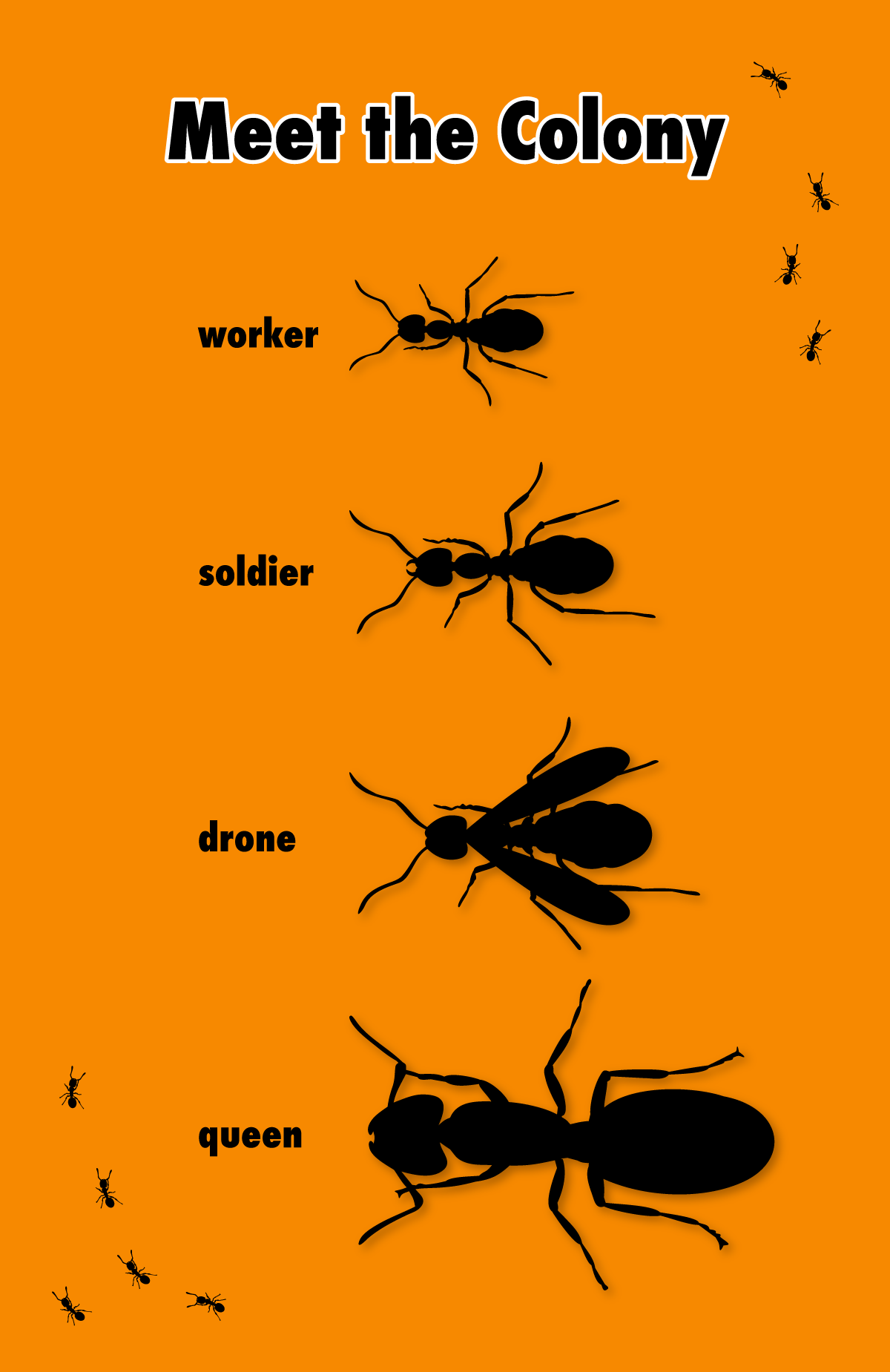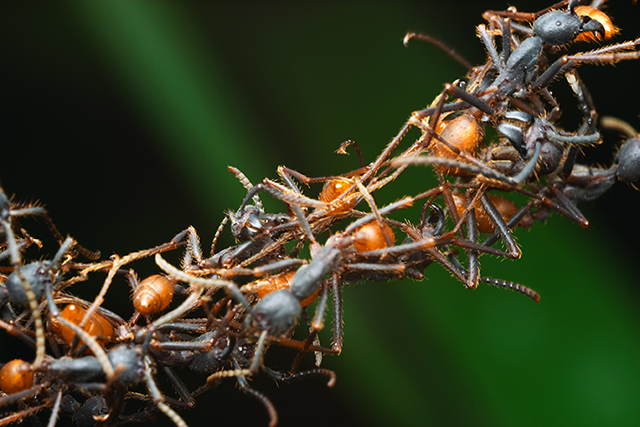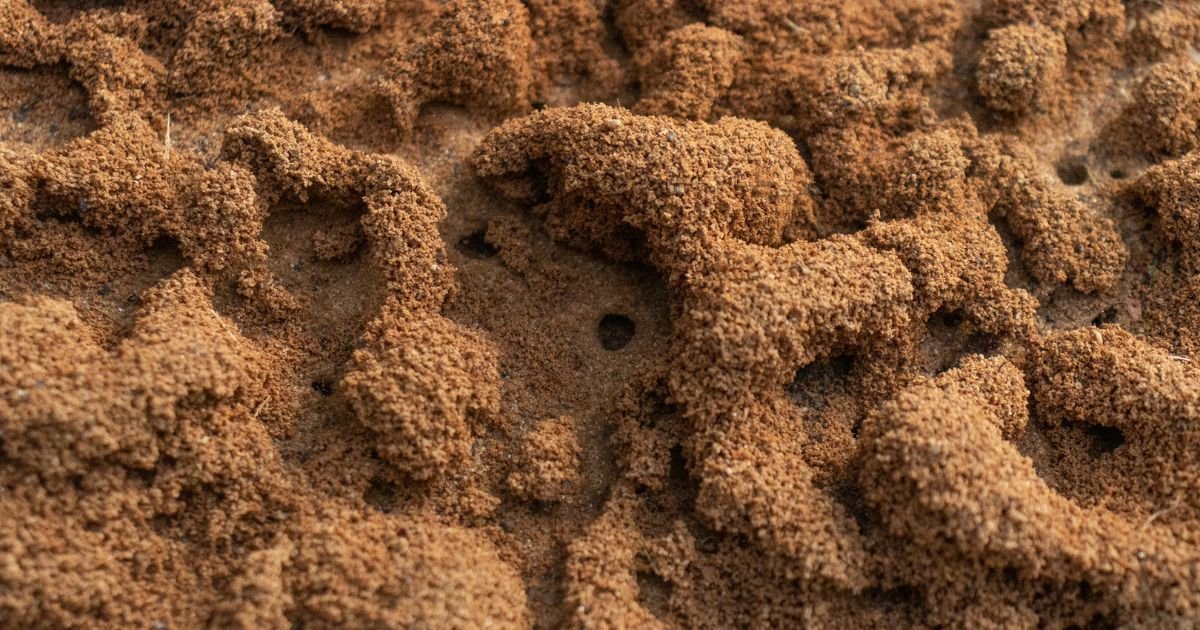Ant colonies operate through a complex social structure led by a queen. Worker ants perform tasks vital for the colony’s survival, such as foraging and nest maintenance.
Understanding the inner workings of ant colonies reveals a remarkable example of biological organization and efficiency. At the heart of the colony’s success lies the queen, whose primary role is egg-laying, ensuring the colony’s growth and continuity. Surrounding her is a network of worker ants, each executing specific roles dictated by their age, size, and genetic predisposition.
These roles range from foraging for food, caring for the young, defending the nest, to expanding the colony’s territory. The enthralling coordination within ant colonies is relentless and instinctive, driven by chemical communicators known as pheromones. This sophisticated form of interaction enables ants to adapt to changing environments and optimize their collective performance, making ant colonies a subject of endless fascination for scientists and nature enthusiasts alike.
The Secret World Of Ant Colonies
Ant colonies represent some of nature’s most complex and efficient systems hidden right beneath our feet. This secret world thrives on teamwork and perfect organization, setting an extraordinary example of nature’s intricacies. With millions of species, each ant colony is a wonder, a society bustling with life, purpose, and relentless drive.
Society In Miniature
Think of an ant colony as a miniature city. Each ant plays a specific role. There are workers, soldiers, and the queen. The workers scavenge for food, care for the young, and maintain the nest. Soldiers protect the colony, ready to act against threats. The queen is the heart of the colony: she lays eggs and ensures the continuation of their world. Just like humans, ants communicate with each other and work towards common goals.
The Ant Colony Ecosystem
An ant colony is a finely tuned ecosystem where everything has a purpose. From the waste management systems to the nurseries for their young, ants create complex structures and networks. Here are key components:
- Nurseries – Designated areas where eggs and larvae are nurtured.
- Food Storage – Spaces for collected food, maximizing survival.
- Tunnels – Transportation networks vital for colony function.
Ants utilize pheromones for navigation and communication, ensuring the colony operates like a well-oiled machine. Their collective intelligence and resource management skills are astounding, rivaling even the most developed human systems.

Credit: supersimple.com
Roles And Hierarchy
Intrigued by the bustling life of an ant colony? Understanding how these tiny engineers organize their society is fascinating. Ant colonies are a marvel of nature’s design. At the core of this well-oiled machine lies a strict roles and hierarchy system. Each ant plays a pivotal part, ensuring the colony’s smooth operation and survival. Let’s delve deeper into the different roles within an ant society.
The Queen’s Dominion
The queen ant is the heart of the colony. Her primary role is to lay eggs. These eggs hatch into the next generation of ants. The queen’s ability to produce offspring decides the colony’s future. She is larger than other ants. Her size helps her with egg production. Worker ants protect and care for her diligently.
Workers And Their Duties
Worker ants make up the bulk of the colony. They are all female and are responsible for various tasks:
- Foraging for food to feed the colony.
- Constructing the nest to protect the queen and brood.
- Protecting the colony from threats.
- Caregiving for the queen and her young.
Each worker is crucial to the colony’s success. They communicate through chemical signals to coordinate these tasks.
The Role Of Male Ants
Males have one purpose: to mate with the queen. They are born with wings and fly out of the nest to find a queen to mate with. After mating, male ants often die. This ensures the colony’s genetics remain diverse. Male ants play no part in nest activities such as foraging or caregiving.
Communication Within The Colony
Ant colonies are marvels of biological engineering. Much of their success lies in the intricate communication system. This system allows possibly millions of individuals to work together. They achieve complex tasks, such as foraging and defending the colony.
Every ant plays a role in supporting the colony. They communicate to create a smooth, functioning community. Ants use chemical signals and physical touch. This helps them share information and stay united. Understanding how ants talk to each other reveals a world of sophisticated social interactions.
Chemical Trails: Ants’ Invisible Highway
Ants leave behind chemical trails with a substance called pheromone. These trails guide fellow ants to food or alert them to danger. Worker ants follow a simple rule: if they find a trail, they follow it. This way they strengthen it for others. Imagine a busy ant highway, where the most traveled paths are the strongest.
- Pheromones act as signals, pointing ants to resources or away from threats.
- Each species has its own unique chemical signals, making their communication system efficient.
- Trails can lead to food, nest sites, or help during colony migrations.
Antennae Interaction: A Tactile Language
Ants use their antennae for more than just feeling around. They are their main sensory organs. Through delicate touches, ants exchange information. This may be about their identity, role, or the state of the colony.
| Antennae Movement | Meaning |
|---|---|
| Quick, Repetitive Contact | Greeting or recognition among colony members |
| Slow, Deliberate Touch | Sharing food or directions |
With these tactile messages, ants can perform tasks with incredible precision and cooperation. They work together to raise young, find food, and protect the colony. The silent world of ants is buzzing with communication.
The Life Cycle Of An Ant
Marvel at the fascinating journey of an ant’s life, from a tiny egg to a full-grown insect. This cycle is a tale of growth, teamwork, and survival. Enter the world of an ant colony and uncover the stages that define the existence of these industrious creatures.
From Egg To Ant: The Developmental Stages
The start of an ant’s life is humble, as a microscopic egg. The transformation from egg to adult is an incredible process. It happens in four key stages: egg, larva, pupa, and adult ant.
- Eggs: The queen ant lays eggs. These eggs are oval and tiny.
- Larvae: Hatched eggs reveal legless larvae. Larvae eat a lot, growing quickly.
- Pupae: Larvae spin silk cocoons, becoming pupae. Inside, they change shape.
- Adults: Eventually, they emerge as workers, males, or new queens.
Life Span And Generational Overlap
Ants experience a remarkable generational overlap. Many generations coexist within a single colony. A worker ant’s lifespan is often several months to a few years. Queens can live for decades. Younger ants replace older ones, ensuring the colony’s continuity.
| Ant Type | Average Lifespan |
|---|---|
| Worker Ants | Several months to 3 years |
| Male Ants | A few weeks |
| Queen Ants | Up to 30 years |
Queen ants are the heart of the colony. They lay thousands of eggs. Worker ants maintain the nest and care for the queen’s offspring. It is a cycle that perpetuates the species and supports the colony’s growth.
Colony Architecture Mastery
Let’s delve into the world of Colony Architecture Mastery. Ants are not just small creatures roaming the ground. They are master builders of complex structures that rival our most intricate cities. Within the heart of an ant colony lies a marvel of engineering: organized spaces, controlled climates, and bustling activities all beneath our feet.
Underground Cities: Nest Structures
Ant colonies are underground metropolises, designed to shelter and sustain their inhabitants. These structures, commonly called nests, consist of many chambers and tunnels. Let’s explore the sophistication of these intricate layouts:
- Chambers serve as specialized rooms for the queen, larvae, and for storing food.
- Connecting tunnels allow for smooth traffic flow and quick responses to threats.
- Each nest has several entrances that provide access and escape routes.
- Construction materials vary: soil, sand, and plant debris are commonly used.
Ants use their jaws to excavate and transport materials, demonstrating impressive coordination and teamwork. They turn simple materials into a fortified stronghold.
Temperature And Ventilation Control
In an ant colony, temperature and air quality are regulated with precision. These factors are vital for the survival of the colony, especially for the vulnerable larvae and eggs.
- Temperature regulation is achieved by constructing the nest at a depth that buffers against the surface temperature.
- Ants can adjust the insulation properties by changing the nest’s material composition and structure.
- Ventilation is a masterpiece of natural engineering. Air flows through the tunnels, drawn in by temperature differences between the nest and the outside.
- Some species even build ventilation shafts, which act like chimneys to expel warm, stale air.
These environmental controls create a balanced habitat that promotes the colony’s health and growth. It’s a delicate balance, with ants constantly adjusting their living spaces to adapt to external conditions.
Foraging And Feeding Strategies
Understanding the intricate ‘Foraging and Feeding Strategies’ of ant colonies reveals a world of efficiency and cooperation. These tiny creatures have mastered the art of finding and distributing food within their complex societies.
Teamwork In Food Gathering
Ants excel at working together to find sustenance for the colony. Their strategies are a marvel of natural teamwork:
- Scout ants venture out to locate resources.
- Their trails guide others to the food source.
- A group effort ensues to transport the food back.
These tireless insects use pheromones to communicate successful routes, ensuring collective success in their quest for food.
Diet Diversity Among Ants
Not all ants share the same menu. Diet diversity is common, with species having unique preferences:
| Ant Species | Preferred Diet |
|---|---|
| Leafcutter Ants | Fungus grown on leaves |
| Carpenter Ants | Proteins and Sugars |
| Army Ants | Other insects and small vertebrates |
Specialized diets help colonies avoid competition and exploit different ecological niches. This strategy ensures the survival of diverse ant species within various environments.
Defense And Survival Mechanisms
Ant colonies are marvels of nature’s engineering. These tiny creatures create complex homes and work together to protect their community. They have amazing defense and survival techniques. The survival of an ant colony depends on how well they can defend their queen and nest from threats. Let’s explore how they achieve this feat.
Protecting The Queen And Nest
The queen is the heart of the colony. Ants go to great lengths to shield her and the nest. The worker ants create a living shield around the queen. They form tight clusters with their bodies. This method keeps the queen safe from predators and harsh weather.
- Worker ants patrol the nest constantly.
- The ants seal off the nest during danger with soil and debris.
- Alarm pheromones alert ants of an intruder.
- Soldier ants with stronger mandibles fight off threats.
Against Predators And Environmental Threats
Ants face many predators, like birds and lizards. They also deal with rains and floods. Their defense strategies are vital for survival.
| Type of Threat | Defense Strategy |
|---|---|
| Predators | Release formic acid, bite, and sting |
| Environmental Threats | Build nests in high ground, waterproofing |
Ants work together to adapt to threats. They move the entire colony if needed. They also change the structure of their nests. Teamwork is their best defense.
- Chemical signals guide ants to safety.
- Ants form ant rafts during floods.
- They use their bodies to plug holes in the nest.
Ants teach us about resilience, cooperation, and adaptation. Their colony’s success hinges on their defense and survival mechanisms. The small ant is mighty indeed.

Credit: www.researchgate.net
Reproduction And Colony Expansion
Ant colonies are marvels of nature’s engineering and their success lies in effective reproduction strategies. Whether expanding existing families or creating new colonies, ants employ methods that ensure their survival and dominance in various ecosystems. Let’s dive into the fascinating world of how ant colonies reproduce and expand.
Nuptial Flights: The Birth Of New Colonies
Nuptial flights symbolize the beginning of ant colony expansion. This event is like a grand insect wedding in the sky. Future queens and males, called alates, take flight on warm, humid days. Crowds of these winged ants fill the air, creating an awe-inspiring spectacle.
- Virgin queens mate with males from other colonies.
- Once mated, females shed their wings and search for a nesting site.
- The new queen lays eggs, establishing her own colony.
This critical phase ensures genetic diversity and the spread of ant populations across vast regions.
When Colonies Multiply: Swarming And Budding
Beyond nuptial flights, ants also multiply through swarming and budding. These processes facilitate the growth of ant communities, securing their place in the environment.
Swarming involves a large group of worker ants and a queen departing the original nest. They form a new colony nearby. Budding happens when a smaller group breaks off with a queen. They stay more local and expand gradually.
| Swarming | Budding |
|---|---|
| Large group of ants | Smaller group of ants |
| New colony farther away | New colony nearby |
| Quick expansion | Slow, steady growth |
Both methods play a crucial role in the survival and spread of ant colonies. Understanding these strategies provides insight into the resilience and organization of social insects.
The Impact Of Ant Colonies On The Environment
Ant colonies profoundly shape their environment, quietly orchestrating the world beneath our feet. These tiny creatures are far more than just backyard inhabitants. They are major players in the ecological theater, affecting soil structure, plant life, and even the survival of other animal species. Let’s delve into how these miniature architects influence their surroundings.
Ecosystem Engineers: Ants’ Role In Nature
Ants play a pivotal role as ecosystem engineers. Their activities foster a healthy environment in several ways:
- Aeration: Ant tunnels allow air and water to flow through the soil.
- Decomposition: Ants break down organic material, enriching the soil.
- Seed Dispersal: They carry seeds, aiding plant diversity.
Through these actions, ant colonies promote growth and balance in nature.
Ant Colonies And Human Interaction
Humans and ants constantly interact, often without us even realizing it. Ants impact agriculture and gardens in a few key ways:
- Ants control pests by eating their eggs and larvae.
- They pollinate flowers during their search for nectar.
- Ants can also become pests themselves, especially when they protect aphids for their sweet secretions.
Thus, ant colonies can be both beneficial and challenging for humans.

Credit: www.quantamagazine.org
Frequently Asked Questions Of How Do Ant Colonies Work
How Is An Ant Colony Structured?
Ant colonies are structured hierarchically with a queen at the top, whose primary role is egg-laying. Worker ants maintain the colony, forage for food, and protect the nest. Drones and future queens are present for reproduction.
What Roles Do Worker Ants Play?
Worker ants are multitaskers, responsible for foraging, feeding larvae, nest construction, and colony defense. Each worker follows a strict age-related job rotation, starting within the nest and eventually venturing out as they age.
How Do Ants Communicate With Each Other?
Ants communicate through pheromones, which are chemical signals. They use these for navigation, identifying food sources, sounding alarms, and coordinating tasks. Ants lay pheromone trails that others follow, creating efficient paths to resources.
How Long Does An Ant Queen Live?
An ant queen can live for several years, with some species’ queens living up to 30 years. Her longevity is essential for the colony’s continued survival and growth as she is the sole egg-layer for the entire colony.
Conclusion
Ant colonies showcase nature’s intricate systems, functioning with remarkable efficiency. Understanding the roles within a colony enlightens us about cooperative survival. These tiny architects craft ecosystems, important for biodiversity. Embracing their wisdom, we learn teamwork’s true power. For a flourishing habitat, let’s respect these industrious insects and their profound work ethic.

I’m MD Tanvir, and I bring years of expertise gained from working closely with pest control companies to the forefront. My journey in the industry has inspired me to launch Bug Battler, a platform aimed at equipping people with the know-how to combat pests autonomously. Through Bug Battler, I aim to empower individuals with practical insights to tackle pest infestations effectively.

